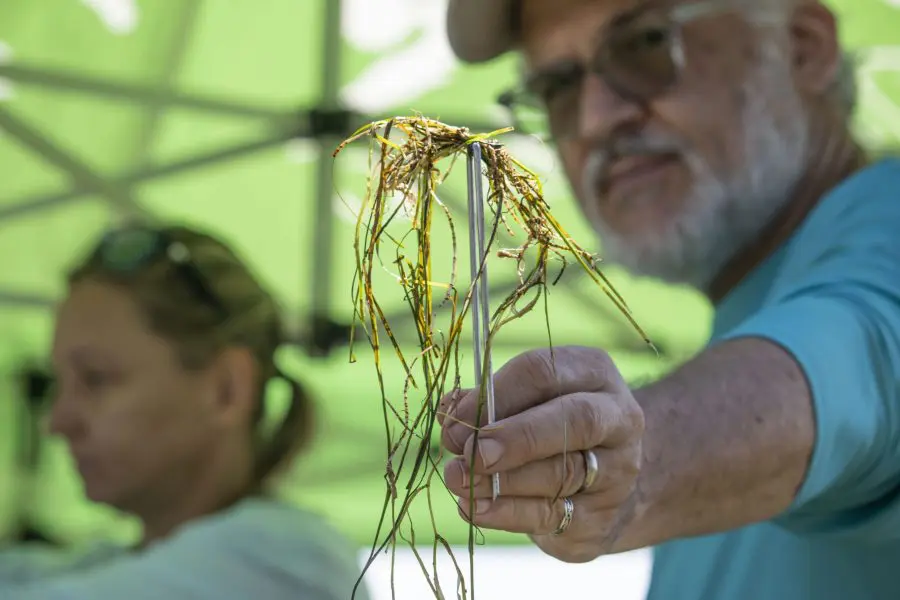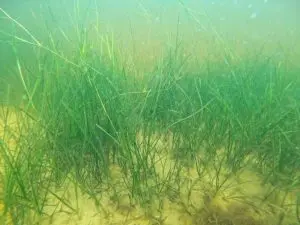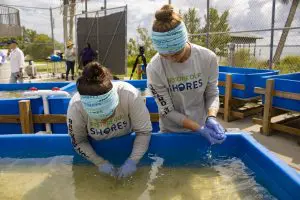

We’ve made waves in seagrass restoration.
We’re celebrating World Seagrass Day by giving you an update on some of our important seagrass conservation work happening right in our (and possibly your literal) backyard.
The Indian River Lagoon is one of the most biodiverse estuaries in North America, and it thrives off being a seagrass-based ecosystem. The lagoon once had many seagrass meadows, which provided a home and food supply for the native fauna, stabilized the seafloor and prevented coastal erosion.
Unfortunately, algal blooms caused by nitrogen pollution have prevented sunlight from reaching the seagrass beds. This has resulted in acres of seagrass being wiped out, leading the native species to suffer.
“There is very little seagrass left in the lagoon and lots of seagrass herbivores are looking for food, including fish, crabs, and manatees.” said Senior Conservation Manager, Olivia Escandell.
To combat this issue, we have two big seagrass projects currently underway with our conservation team, Restore Our Shores: planting and monitoring experimental seagrass beds throughout the Indian River Lagoon as well as supporting two seagrass nurseries.
Monitoring Seagrass Planting Sites
In May of last year, Our Restore Our Shores conservation team began planting 24 experimental seagrass beds in 16 locations across the Indian River Lagoon in hopes of restoring these native grasses to the area and learning more about where larger seagrass restoration efforts would thrive.

Seagrass growth at the Banana River site.
Over the past 9 months, our team has kept track of a wide swath of data across all locations. They’ve documented the seagrass itself – like how tall and expansive the seagrass has grown – and how much algae has grown on the blades of individual grasses. They’ve also noted environmental factors such as the water temperature, air temperature, salinity, water depth, pH and more.
After this intensive monitoring, there have been some standout sites. Olivia was enthusiastic to mention that seagrass remains at 14 of the original 16 locations, with significant growth and dense coverage at several sites, including Banana River, Titusville, Malabar, and Melbourne locations.
Growing Seagrass in Nurseries
Last year, we also started up both of our seagrass nurseries, which we hope will eventually help us populate the lagoon. Since most of our nursery seagrass was planted toward the end of September, and the plant can become dormant in the winter, we haven’t noted much growth over the past few months. However, once spring has finally sprung, the team will start fertilizing the sandy soil to help boost growth rates.

Our team planting the initial seagrass in the nursery in 2023.
Olivia is optimistic that by June some of the nursery grass will be grown enough to be transported and planted in the lagoon. Seagrass growth peaks in July and August, so we hope to have full nurseries throughout the summer, too.
“We will not be planting in the same footprint, but with a different design that will help us answer questions about how long we need to keep seagrass protected with exclusion devices. We may replant at more sites in the future since repetition of the experiment can strengthen findings,” said Olivia.
It’s also important to note that these projects would not be as successful if it was not for our dedicated volunteer base and strong partnerships and donors within the community. The planting and monitoring work was funded by generous Zoo donors and the nurseries are supported by the Indian River Lagoon National Estuary Program.
“Thank you to all our volunteers helping care for the nurseries so dutifully and for our partners who continue to help us learn how to grow seagrass. We are very lucky to have great partnerships with other seagrass nurseries and scientists,” said Olivia.